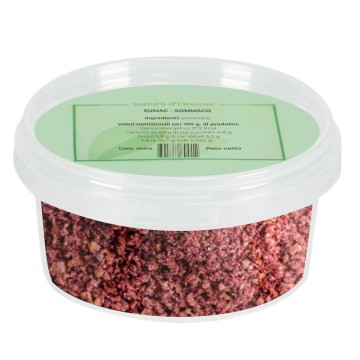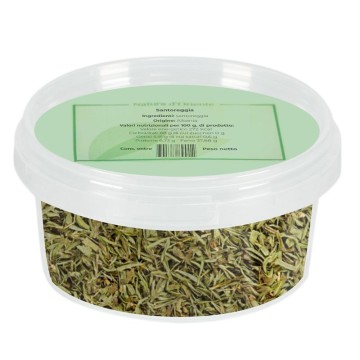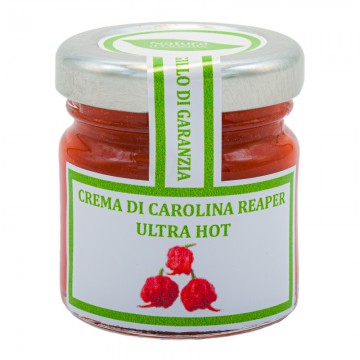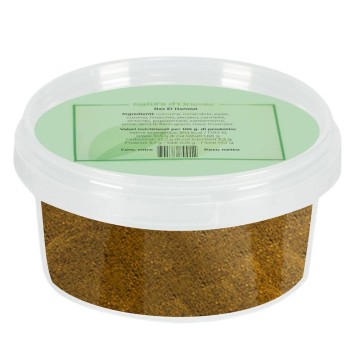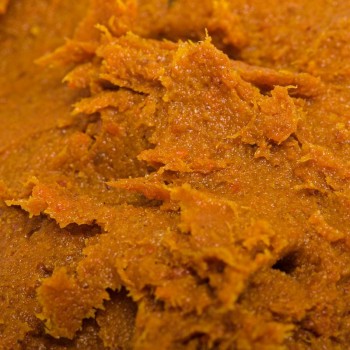The seeds of this plant have been known for centuries as a spice, used both whole and ground as in this convenient version. Fenugreek powder is a spice known especially in many Indian dishes and curry mixes, since the plant is widespread spontaneously in India as well as in Europe. This seasoning is appreciated for its pungent and slightly bitter, astringent taste; known for its spicy and strong aroma. The version of fenugreek powder is convenient and practical, allowing you to easily integrate this spice into ground dishes and seasonings.
What are the properties and benefits of fenugreek powder?
The seeds of this plant have been known for centuries as a spice, used both whole and ground as in this convenient version. Fenugreek powder is a spice known especially in many Indian dishes and curry mixes, since the plant is widespread spontaneously in India as well as in Europe. This seasoning is appreciated for its pungent and slightly bitter, astringent taste; known for its spicy and strong aroma. The version of fenugreek powder is convenient and practical, allowing you to easily integrate this spice into ground dishes and seasonings. Fenugreek: properties and benefits This spice is useful to the diet not only from an aromatic point of view, but also to obtain beneficial compounds for our well-being. In particular, fenugreek has an emollient action on the digestive system thanks to the fibers and mucilages contained in the seeds. The digestive function can improve, thanks to the soothing properties on the gastrointestinal tract that soften the tissues and the mass of food assimilated in transit - against constipation. These actions are also due to the trigonelline molecule, contained in the seeds, which has not only emollient but also expectorant properties for the respiratory tract.
As a digestive spice, in the tradition of natural remedies, fenugreek has also been considered an appetite stimulant, rich in nutrients useful for debilitated people and to regain lost weight. The action of fenugreek affects the metabolism of carbohydrates, as a support to regulate glycemia - blood sugar levels. In addition, it has a role in the metabolism of lipids and triglycerides, promoting the control of cholesterol in the blood - inhibits absorption at intestinal level. The seeds also contain phytoestrogens, known in herbal medicine for their beneficial contribution in the production of breast milk. They contain dietary fiber, antioxidants and minerals including iron, potassium, magnesium, copper and manganese. It contains micronutrients such as proteins, amino acids and vitamins (A, B group, C, D and P).
The mucilage contained in fenugreek seeds is also known for external applications on skin and hair, with nourishing and emollient effects. A cleansing mask for the skin is usually created by mixing fenugreek powder (about 5 g) with warm water (about 2 tablespoons) of water, until it forms a paste. You can also use milk or yogurt to make the wash more beneficial. For a moisturizing cream, you can combine the powder with liquid coconut oil, and alternatively use lemon juice instead of coconut oil, for the hair. This spice also has qualities as a home remedy: thanks to the strong smell it gives off, fenugreek powder is useful for keeping away animals such as moths and bedbugs.
Fenugreek is a safe spice in most cases. However, it may lead to side effects if taken in excessive doses, such as reduced appetite or interaction with diabetes medications that reduce blood sugar.
Using ground fenugreek in cooking
The powdered version of fenugreek is known in spice blends, such as Indian ground curry, where it is a frequent ingredient. It is one of the characteristic flavors of Indian or African mixes, with a warm, pungent flavor and a bitter aftertaste; strong and intense, fenugreek is an excellent match with other oriental spices. It works well as part of a blend in combination with other flavors, with its slightly bitter notes balancing sweet flavors, and bringing out the spiciness. Ground fenugreek, in fact, is excellent used with cumin and coriander. It can enhance the flavor of a dish but can also ruin it if used excessively - just a pinch of fenugreek powder is enough to make a strong tone. Dried fenugreek seeds powder enhances the pungent flavor and depth of the spice when added to ingredients such as oil or butter. They should not be subjected toosti at high temperatures, otherwise they develop a too pungent, bitter taste and an acrid aroma. The version of ground fenugreek seeds is convenient, to be incorporated easily into dishes, without having to toast or grind the whole seeds.
Savory recipes: a pinch of this spice transforms a bland dish into an appetizing one, whether it is a first course or a second course. It works well in combination with other spices for rice, stews, soups, legumes and vegetables (finishing). You can mix fenugreek powder with olive oil or butter, creating a dressing to use on salads, stir-fry meats, cereals. It is also used for canning.
Flavoring: Fenugreek powder is a common spice in Indian, North African and Middle Eastern cuisine. It can be used as a sprinkle at the end of cooking or at the beginning, as an ingredient in sauces. You can use fenugreek powder like any other spice for flavor. It is used in the Ethiopian seasoning recipe of Niter Kibbeh, a clarified butter with herbs and spices including fenugreek, cardamom, cumin, and cinnamon.
Blends: The ground seeds are added to popular spice mixes such as garam masala, panch phoran (Indian five-spice), berbere, or barbecue seasonings. They can be combined with other strong spices such as coriander, cumin, and paprika. The powdered version can also be mixed into a paste and applied directly to the skin or scalp.
Drinks: A common way to consume fenugreek powder is to mix it with milk, water, or tea for infusions. It can also be mixed into a paste and applied to the skin or scalp for a more direct benefit. However, fenugreek powder is more than a health remedy and is often used as a flavorful spice in soups, curries, and other dishes. If you choose to use fenugreek powder, tell your doctor if it is safe with any medications or conditions you have.
Sweet recipes: It is used in rice pudding and can be incorporated into desserts, although its bitter taste and strong aroma are usually not appreciated in desserts. For those who want to incorporate this spice, it is conveniently used in powder form in baked goods such as bread, buns, pancakes, crackers, etc.
Fenugreek Rice Pudding
Ingredients: 1 cup basmati rice - 4 cups milk - 4 tablespoons sugar - ¼ teaspoon cinnamon - ¼ teaspoon cardamom - ¼ teaspoon fenugreek powder. Preparation Start by boiling the basmati rice in the milk. Then, add the sugar along with the fenugreek powder and the other spices. Let the rice simmer for about 20 minutes, or until it is thick and creamy, stirring to prevent it from burning. If necessary, add 100 ml of milk to loosen the pudding. Serve topped with honey and fruit if desired.
Origin and cultivation
Fenugreek comes from the plant Trigonella foenum-graecum, belonging to the Fabaceae family. It is a species native to the Middle East and North Africa, which grows spontaneously in the hills and on the coasts.
The name Trigonella refers to the triangular shape of the seeds, while it is called hay for its use as feed for livestock, since ancient times. This plant, in fact, has origins around 1500 BC considered both as fodder for animals and as a medicinal herb by the ancient Persians, Egyptians, Greeks and Romans. It was already known in Chinese medicine, to treat skin and other pathologies; Since then it has remained in the Eastern tradition as a spice and natural remedy.
In Europe, fenugreek began to spread successfully after the 9th century, probably thanks to the Benedictine monks. It was considered a beneficial herb for toning and revitalizing the body. Even today it is found as a common spice in cooking, but also as a thickening agent and ingredient in cosmetics such as soaps and shampoos.
The fenugreek plant is about 60-90 centimeters tall, produces green leaves, small white flowers and pods that contain the small fenugreek seeds, golden brown in color. In addition to being harvested as whole grains, they can be dried and ground, to be marketed as fenugreek powder.

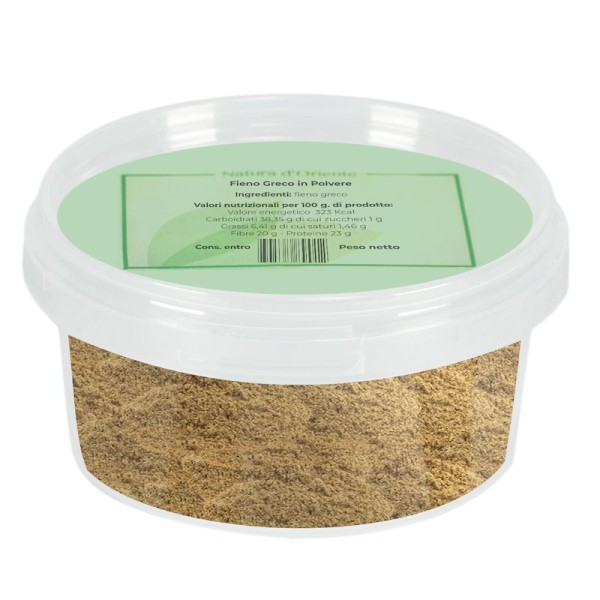







 No reward points for this product.
No reward points for this product.


